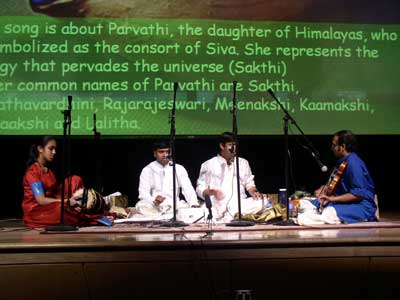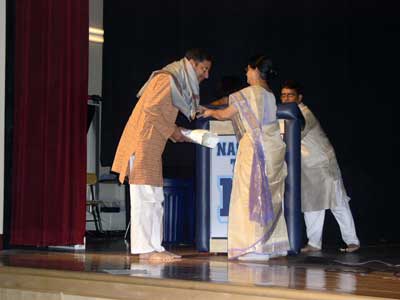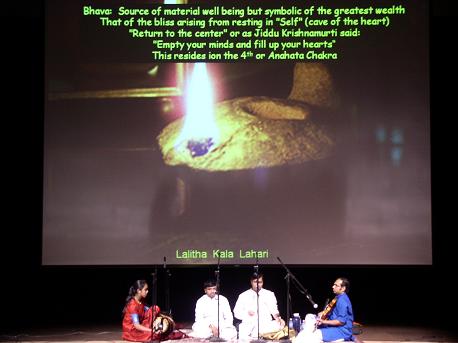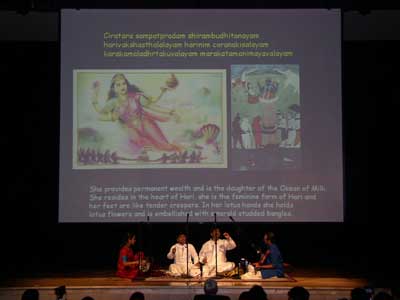Contribute
| Not A Dull Moment At The Sashikiran And Ganesh Music Concert |
Dr.Guha Krishnaswamy
05/10/2006
A special thematic concert "Saptaswara Saptabhava" was organized by Lalitha Kala Lahari on the 29th of April 2006 Nashoba Valley Tech School - Westford, MA. The concert began with a multimedia overview of basic Hindu philosophy and the relationship of the seven chakras to the seven endocrine glands and the seven notes by Dr. Guha Krishnaswamy, from Tennessee. The invocation "Yaa devi sarvabhuteshu buddhi rupena smasthitaa, namstasyai, namastasyai, namastasyai namo namaha" was followed by a brief description of the role of "shakti" in Indian lore. The idea of "shakti" or the female divine energy source as the basis of manifestation of the trinity of Shiva, Vishnu and Brahma, according to some traditions, was emphasized. The seven notes, according to some scholars, correspond to the seven chakras and positionally to the seven chief endocrine glands. Hence in nadayoga, the yoga of sound, the seven swaras have been deftly used by the composers and the musicians performing the compositions, to activate these various centers. The goal would be to allow the blossoming of the sahasrara chakra which could be said to correspond to the pineal gland and to the nirguna Brahman or the undifferentiated reality. Krishnaswamy used the example of Sri Thyagaraja's famous composition, Terateeyagarada. This starts at a level below mooladharachakra, where base emotions such as the jealousy that the bard is talking about, arise. The composer then takes the words, paramapurusha or supreme Reality to the Sahasrara chakra, suggesting that the mind needs to be pulled up by the bootstraps to that point for realization to occur.
After this brief introduction, the concert by the melodious and well-respected Carnatica Brothers (Sri KN Sashikiran and Sri P. Ganesh) began. They were very ably accompanied by the very young artist, Rajna Swaminathan (disciple of maestro Umayalpuram K. Sivaraman) on the mridangham and by VVS Murari (disciple of Sri Semmangudi Srinivasa Iyer) on the violin. The concert utilized a multimedia format in which information on the song lyrics, meaning, ragam and composer were provided in the background screen. Seven cardinal manifestations of shakti or Devi-consciousness were elaborated over three hours or more. After a brisk varnam in the ragam andolika (composition of Sri G.N. Balasubramaniam), an invocatory piece on Ganesa followed which was a rare and beautiful piece, Pranavakaram, in Arabhi. This was followed by a moving song in Natal, Saraseeruhasanapriye, venerating Saraswati, the guradian of intellect and self awareness. Shakti was extolled movingly and melodiously as spiritual wealth (Hiranmayeem Lakshmim, the composition of Sri Muthuswamy Dikshitar in the ragam Lalitha), the essence of all manifest creation (Amba Janani, composition of Subbaraya Sashtri in the ragam Reetigowla), as the source of all compassion (Ananda Amrithavarshini in ragam Amrithavarshini), the yogini par excellance who resides in the trilokya mohana chakra (Santhatam aham seve, a composition of Ootukkadu Venkatasubbayar set in the rare ragam, desakshi), as one who confers self realization or supreme knowledge (akhilandeswari in the ragam Dwijavanthi) and finally as one who is seen as the destroyer on the inner enemies (symbolized by the demons bhanda, chanda, munda and mahisha). In one of the slides, Krishnaswamy emphasized that these are not external demons, but symbolized the internal weaknesses and the descent to the lower chakras. Here Devi Bhava manifests as awareness or insight that can rid one of these weaknesses (lust, anger, jealousy, desire, hatred and other ego-born delusions).
These songs extolling the seven manifestations of female divinity were followed by the main piece, the well known swarajathi, Amba Kamakshi, a composition of Sri Syama Shastri in the ragam Bhairavi set to Misra Caapu talam. The alapana by Sri Sashikiran and then by Sri P. Ganesh drew the audience to tears and established the basic substrate of the entire concert: that shakti or the energy source forms the basic platform for all human existence. The swara sahityas were followed by elaborate and skilled neraval and kalpana swarams that brought out the mastery of the musicians. Rajna Swaminathan enthralled the audience by an outstanding tani avarthanam (solo percussion piece). The main piece was followed by a few audience requests (such as English note, Samaja varagamana) and concluded with a mangalam, the composition makkutake mangalam, in madhyamavati by the great bard purandaradasa. The combination of a multimedia program with outstanding musical outpourings left the audience in a highly meditative state.
You may also access this article through our web-site http://www.lokvani.com/



